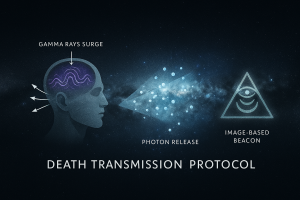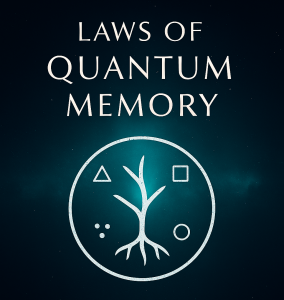What Is Quantum Memory?
At this point, we’ve danced around Quantum Memory — hinted at it, used it in analogies, and even told stories that assume it’s there.
But now we have to face the question directly: What is it?
Here’s the hard truth: we don’t know.
And maybe that’s the point.
Some will call it an energy field, invisible but measurable, holding the sum total of all lived experiences.
Others will picture it as a particle phenomenon, woven into the quantum foam of spacetime itself, where every interaction leaves a permanent trace.
Some might even argue it’s not “physical” at all — that it’s a fundamental property of reality, like space, time, and gravity.
The easiest analogy?
If the universe is a computer, then matter is the hardware, energy is the electricity, and Quantum Memory is the ROM — the permanent read-only storage that holds the code of everything that has ever happened.
Our brains? They’re the RAM — quick, temporary access for the here and now, constantly reading from and writing to the bigger, permanent archive.
But here’s the strange part:
We’ve never found a “location” for Quantum Memory. There’s no single place in the brain where it’s stored, no cosmic server in some corner of the universe. The best way to think of it is as a non-local network — everywhere and nowhere, woven into the very structure of reality.
And that leaves us with the most important idea of all:
If it’s everywhere, then every one of us is a node in the system.
We’re not just living in reality — we’re constantly recording it, transmitting it, and receiving it. Every thought, every moment, every flash of emotion — all of it is etched into the field.
Is it conscious? Probably not. If it were, the temptation to manipulate would be too great — even for a god. More likely, it’s a byproduct of creation itself, like the way a shadow is cast whether you intend it or not.
Where traditional neuroscience treats memory as an internal phenomenon, QM reframes it as an external, shared repository. Our brains are not vaults of memory—they are nodes in a much larger system, constantly uploading, downloading, and occasionally cross-connecting with other stored experiences.
Think of QM as:
- A Library Without Walls – Every experience is a “book” stored forever, available to any “reader” who knows how to access it.
- An Ocean of Information – Our lives create ripples, currents, and waves in the field. Some fade quickly; others endure for centuries.
- A Communication Layer – Just as computers share data across a network, minds share impressions, instincts, and insights through this field—often without conscious awareness.
The defining traits of QM are:
- Persistence – Once a memory is stored in the field, it does not degrade with time.
- Accessibility – Under certain conditions—whether through instinct, trauma, creativity, or meditation—memories not our own can surface.
- Interconnectivity – Every node (brain, organism, possibly even certain objects or structures) can contribute to, and draw from, the field.
This definition doesn’t require QM to be conscious or intelligent. It may be nothing more than a fundamental byproduct of the universe’s architecture, just as gravity is.
But if it is conscious… then it is the most vast and ancient intelligence we will ever encounter.
For now, we will treat QM as a universal memory field—the signal that never sleeps. In the next chapter, we will begin mapping its possible “laws,” the consistent principles that might govern its behavior.
For all our metaphors, there comes a point where we have to plant a flag and say, This is what we mean.
Quantum Memory (QM) is the persistent field of information that records, stores, and transmits the experiences of all things — living or not. It’s not just stored locally in brains or DNA; it’s a universal archive that exists outside of individual organisms.
If this is true, then we should be able to describe it mathematically. And while this is an early attempt, here is our first expression of Quantum Memory as an equation:
QM = (Σ I * E) / Δt × R
Where:
- I = Imprint Strength (the depth of the memory)
- E = Emotional Resonance (how much energy the memory carries)
- Δt = Passage of Time (how long the memory has to fade)
- R = Repetition Factor (how often it’s reinforced)
- In plain terms:
The more emotionally charged and repeated an event is, the stronger its imprint on Quantum Memory — and the longer it persists against the erosion of time.
An Ancient Example – The Amphibian’s First Step
Imagine an ancient amphibian, half fish, half land-dweller, crawling onto the shore. Its gills ache for oxygen-rich air, but it can’t breathe it well. It slips back into the water, struggling, but it tries again the next day. And the next.
Now imagine millions of amphibians, across millions of years, making the same attempt — driven by instinct, hunger, or perhaps an awareness that survival might be better on land. Each attempt leaves an imprint in QM: the desire for land-breathing capability.
Over time, that desire doesn’t vanish — it compounds. Each generation inherits not just genetic mutations, but also subtle nudges from the field — shaping behavior, reinforcing adaptations. Eventually, evolution “answers,” and lungs emerge.
This is not a mystical miracle. It is information persistence, acting over deep time.
From Equation to Principles
If QM can shape life in this way — archiving intent and reinforcing it until it manifests physically — then it must operate under rules.
The next chapter will present these as the Laws of Quantum Memory — the first framework for how the field stores, shapes, and transmits reality itself.
Author’s Footnote:
Some readers will ask — But what if it’s alive?
I get it. If something holds all knowledge, all history, all experience, it’s tempting to imagine it plotting, shaping, even judging. But I don’t believe that’s the case. In my view, QM doesn’t think. It doesn’t want. It simply is.
The danger of imagining it as conscious is that it invites fear — and fear invites control. We’ve seen too many examples in history where people weaponized belief to control others. Let’s not give them another excuse

